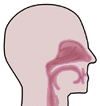  |
||
 |
May 2021Are there Structural and Functional Changes in all Bodily Mucus Secretions?We have characterized secretions that bathe the oral cavity [(saliva) (1)] and the nasal cavity [(nasal mucus) (2)]. There are structural and functional similarities between these two fluids which help maintain structures in the oral cavity (saliva) and in the nasal cavity (nasal mucus). But what about the gastrointestinal tract — it is lined with a layer of mucus over its entire length from the entrance in the esophagus to its exit in the rectum. Are there similarities in these secretions to those in the mouth and nose? The answer to this question is an emphatic yes. However, most clinicians have not considered these similarities although their existence is crucial to the function of the oral cavity, the nasal cavity and the gastrointestinal tract. In each structure, saliva and nasal mucus coexist with a variety of bacteria, fungi and viruses. Indeed, some components of saliva and nasal mucus are antibacterial, antifungal and antiviral. A recent study on gastrointestinal mucus indicates how proximal colon control of mucus production is an important element in the regulation of host-microbiota symbiosis (3, 4). But these secretions perform other similar functions which allows for protection and nutrition for the cellular components which they bathe. As we have shown there are biochemical similarities between saliva and nasal mucus. There are probably similar structural similarities among all these fluids to allow them to maintain the integrity of the structures which they bathe. Biochemical analyses of saliva and nasal mucus demonstrated specific deficiencies which characterized pathology in patients with taste and smell dysfunction (1, 2). Are there similar biochemical deficiencies in gastrointestinal mucus which will demonstrate abnormalities in patients with diseases of the gastrointestinal tract? 1. Henkin RI, Lippoldt RE, Bilstad J, Wolf RO, Lum CK, Edelhoch H. Fractionation of human parotid saliva proteins. J Biol Chem. 1978;253:7556-7565. 2. Henkin RI, Doherty AE, Martin BM. Nasal seroproteins: a new frontier in the exploration of physiology and pathology of nasal and sinus disease. In: Veldman JE, PassÓli D, Lim DJ, Eds. New Frontiers in Immunobiology. The Hague: Kugler; 2000, p. 127-152. 3. Bergstrom, Kirk, Shan, Xindi, Casero, David, Batushansky, Albert, Lagishety, Venu, Jacobs, Jonathan P, Hoover, Christopher, Kondo, Yuji, Shao, Bojing, Gao, Liang, Zanberg, Wesley, Noyovits, Benjamin, McDaniel, J Michael, Gibson, Deanna L, Pakpour, Sepideh, Kazemian, Negin, McGee, Samuel, Houchen, Courtney W, Rao, Chinthalapally V, Griffin, Timothy M, Sonnenburg, Justin L, McEver, Rodger P, Braun, Jonathan, Xia, Lijun. Proximal colon-derived O-glycosylated mucus encapsulates and modulates microbiota. Science Magazine, Vol. 370, Issue 6515, 2020, p. 467-472. 4. Birchenough, George M.H., Johansson, Malin E.V. Forming a mucus barrier along the colon. Science Magazine, Vol. 370, Issue 6515, 2020, p. 402-403. |
|